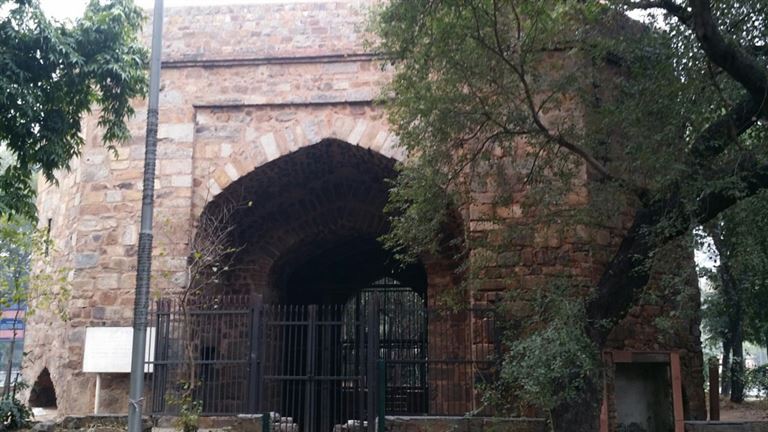
I have driven past the Khooni Darwaza many a times as its very close to Firoz Shah Kotla,a favourite haunt of mine but few days ago I decided to explore it.
Not many know that this gate was built by Sher Shah Suri for his city Shergarh (Purana Qila area) and was named Kabuli Darwaza because caravans to Afghanistan passed through this the northern gate of Sher Shah’s city according to Maulvi Zafar Hasan in his famous book.
So at least till 1919 when Monuments of Delhi was published it was called Kabuli Darwaza or Lal Darwaza because of the red stone used.
The facade of the gate is imposing amd measures 53’5″ in width and has a height of 50’9″ from base to top of the parapet. Its been built of Delhi quartzite.
This gate is now fenced in with its own patch of wilderness and wild grass and very few who pass by it know of its gory past.
The reputation of this gate was already bloody to start with since it is said that Emperor Jahangir had the two sons of Abdur Rahim Khan-i-Khanan, a minister in his father Akbar’s court, killed and hung on this gate. Khan e Khana had supported the claims of Jahangir’s son Khusrau, who was also Akbar’s favourite against Jahangir and so paid the price later.
It is said that Aurangzeb also displayed Dara Shikoh’s head here after he had him killed in the War of Succession.
The name Khooni Darwaza alludes to the cruel and unprovoked act of Major Hudson on 22nd September 1857, when he was taking the sons of the Mughal Emperor, (who had surrendered to him in Humayun’s tomb) to the Red Fort. Mirza Mughal* who had been the initial leader of the Mughal troops against the British and Mirza Khizr Sultan and grandson Mirza Abu Bakr, were being taken in a bullock cart.
As the procession went towards Red Fort they were joined by citizens of Delhi who had white cloth tied on their heads- kafan baandh kar niklay hain.
Near the Kabuli Darwaza, Hodson panicked, fearing an attack against himself and his men, 100 in number. Hudson panicked that rescue of the princes may overturn the tide against the British who had subdued the “mutiny” after much bloodshed and effort. He shot the princes in cold blood.
“Hudson latter recalled, “I was surrounded on all side by Ghazis as far as my eyes could see.” According to Archaeological Survey of India’s, board on the site/gate, it says Hudson, made them remove their “upper” garments) and using his service “sword” he “hacked”/cut the heads of all three sons, and entered the carriage and “slaughtered all men, women and children.” Others assert that Hodson ordered the three to get down at the spot, stripped them naked and shot them dead at point blank range.” (Source Wikipedia)
It is said that after killing the prince, Hodson personally stripped their bodies of jewellery, this being the signet rings, turquoise arm-bands and bejewelled swords worn by the three princes. He pocketed these valuables as trophies of war, although they had been obtained by killing disarmed prisoners of war under dubious circumstances. He took the naked bodies of the princes, to the Chandni Chowk where they were left to rot in the sun in front of the kotwali for days.
Hodson was later censured for this by the British authorities but by then it was too late and the barbaric deed was done.
The Gate is kept locked after a student of Maulana Azad Medical College was raped here in 2002.
And it has this board kept inside for some reason
It is built on 3 levels with staircases leading to the top. The different floor levels of the gate are marked by windows framed in red sandstone each furnished with a balcony carried on heavy quartzite corbels.
“Heavy kangura battlements rubble built and dressed with grey stone,crown the parapet of the gate and thevstring course immediately below them,being broken over the central arch by three damaghah intended for the vertical discharge of projectiles or boiling oul.” (Zafar Hasan)
It is today lying totally abandoned and i saw one man sitting in the cold with a small bonfire going
From afar it seems so innocuous and innocent but even during the Hindu Muslim riot of 1947 many refugees were killed while they were proceeding towards Purana Qila for shelter through this gate.
Bahadurshah Zafar with this two sons – Ten year old Mirza Mughal (standing at right side of the image) and Mirza Fakhru (at left side of the image)
*In May 1857, sepoys of the British Indian army rebelled against their British officers and streamed into Delhi. A few days later, Mirza Mughal and some of his half-brothers petitioned their father to be appointed in charge of the rebel troops. Their plea was initially refused but later granted, and Mirza Mughal was designated commander-in-chief. Mirza Mughal had no training or experience for his new office; however, he energetically sought to organize the troops, make arrangements for their billeting and provisioning, and bring a semblance of order to the edgy city. He was later replaced by Bakht Khan as commander in chief.
Location: On Bahadur Shah Marg in front of Feroz Shah Kotla stadium. Nearest place is Pragati Maidan

